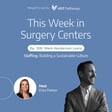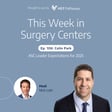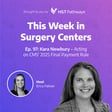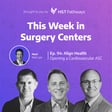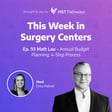Become a Creator today!Start creating today - Share your story with the world!
Start for free
00:00:00
00:00:01

Janet Carlson – 6 Tips for Improving OR Utilization
Enhancing OR utilization is crucial for boosting your ASC’s financial performance, but knowing where to start can be challenging. In today's episode, Janet Carlson, the Executive Director of ASCs at Commonwealth Pain & Spine, shares six actionable tips to help you book more cases at your surgery center efficiently. Janet's strategies focus on preventing staff burnout and ensuring physician satisfaction.
Following our conversation with Janet, we will transition to our Data & Insights segment. We will dive into claim denials, exploring the average denial rate for ASCs, the significance of tracking this data, and practical advice for reducing denial rates.
Resources Mentioned:
HST’s State of the Industry Report
Brought to you by HST Pathways.
Transcript
Introduction and Format Overview
00:00:01
Speaker
Welcome to This Week in Surgery Centers. If you're in the ASC industry, then you're in the right place. Every week, we'll start the episode off by sharing an interesting conversation we had with our featured guests, and then we'll close the episode by recapping the latest news impacting surgery centers. We're excited to share with you what we have, so let's get started and see what the industry's been up to.
Improving OR Utilization with Janet Carlson
00:00:27
Speaker
Hi, everyone. Here's what you can expect on today's episode. Improving OR utilization is critical for maximizing your ASC's financial performance, yet it can be really tricky to figure out where to begin. So Janet Carlson, who is the executive director of ASCs at Commonwealth Pain and Spine,
00:00:46
Speaker
is on today's episode to give us six tips for getting more cases booked at your ASC and also making sure you do it in a way that does not cause staff burnout and keeps your physicians happy and coming back.
00:01:00
Speaker
And after my conversation with Janet, we'll switch to our data and insight segment. Today we'll break down claim denials. So we'll go through what percent of the average ASC claims are getting denied, why this data point is so important to track and monitor and tips for bringing down that denial rate. If you're looking to improve. Hope everyone enjoys the episode and here's what's going on this week in surgery centers. Welcome to the show.
00:01:30
Speaker
Thank you for having me. Janet, excited to talk to you today about OR utilization. And as we look at surgery center performance, one of the biggest drivers and levers that surgery centers have to improving their financial performance is OR utilization. And you've shared in the past six tips for maximizing OR utilization and wanted to dive into each of those with you today. If that's all right. Happy to. Yes.
00:01:56
Speaker
Great.
Strategies for Staff Scheduling
00:01:57
Speaker
So let's talk about tip number one, which is staggered staff shifts. Yes. What is, what's your point of view on how to use staggered staff shifts to drive utilization improvements? So obviously you want to look at the schedule and understand the volume that you have for those days that you're planning for along with the acuity of the case. Meaning, is it a case that's going to take longer to perform?
00:02:26
Speaker
Is it a patient that's going to need a longer recovery time, which most higher acuity patients do need a longer recovery time. And so when you understand the case mix for that day, I believe it's a best practice to have your leader and the OR and your leader in the pre-op impact you to staff accordingly. And so to stagger the staffing so that you have people coming in.
00:02:53
Speaker
Obviously first thing in the morning to pre-op these patients, but some of the people that may have to pre-op the patients later in the day arrive later in the day in the morning, the same with the OR, you stagger those because you're staggering your starts. Say you have a four room ASC and you have a flip room for a physician, you may be only running room one and three while two and four are flip rooms.
00:03:20
Speaker
In theory, the people that will be working in those other rooms that are the flip room, they could come in a little bit later because they're going to be staying later. And then finally, the PACU, those nurses there should come in later, help out and pre-op as much as they can until the ORs bring their first patients to recovery. But those are the nurses that stay until, and they are the ones that are there to recover these patients with
00:03:48
Speaker
higher acuity joint replacement, orthopedic procedures, high acuity spine fusions, some urology procedures, you name it. But they're the ones that are going to be there late in the afternoon into the evening until the patient meets discharge criteria. Got it. And so it sounds like this is really about customizing your shift schedule. Absolutely. Especially for that issue. So it reflects your surgeons.
00:04:17
Speaker
Because each surgeon is going to have a different case time historical. They also are going to have a different process. So you can't just have a blanket staffing grid. You have to make it as customized as possible to the needs of the physician surgeon and to the patients and.
00:04:36
Speaker
the talent they're going to need in the room, how much time it's going to take to do the case, because we all know there's so much work that has to happen in a preoperative way. And then the prepping and draping of the patient, putting them to sleep with anesthesia, placing a spinal, all of those things have to occur before the surgeon even walks in and is ready to scrub in.
00:04:59
Speaker
It really will help you with your labor margins. If you can get creative around how you stagger your team, that way you help to eliminate burnout as well. And people, the minute people get burned out and disenfranchised, they usually vote with their feet and leave. And you want to make sure that you're taking care of your team as well. Got it. And on that team aspect, you mentioned the burnout. How does your staff like or respond to the staggered approach?
00:05:29
Speaker
They love it. And then if we can be successful in a four to six week stretch and we rotate the early to leave and then stagger it by number to the late stay, the until people, they know far in advance the days that they need to stay late so that if they have to make childcare arrangements or transportation arrangements. Likewise, the converse on the days they leave early, they can go ahead and guarantee
00:05:58
Speaker
that they can go make a personal appointment, go to the dentist, things like that, run errands. And so I allow the team to swap their assignments as needed. I don't police that, if you will. I let their professional adults, I let them switch if it's something that they need. My only request is that somebody is there to take care of the patient. Sure. Yep. Makes sense. Okay.
Rotational Relief Teams
00:06:23
Speaker
What about tip number two, which is rotational relief teams?
00:06:28
Speaker
So again, let's say we have the four or six room ASC and we're doing joints and or spines. You would be best served if you would have a team, obviously you have teams assigned to rooms, but it would be great to have a relief team so that when room one goes down and they've cleaned up and they're ready for a break,
00:06:55
Speaker
The relief team can come in and help with the cleanup turnover of the room and set up for the nest case while room two is already getting ready to go for the flip room for that other physician. The same thing happens in three and four and five and six. And so having this, it's for lack of a better analogy, it's almost like a pit crew. And so the pit crew can come in and get the room ready for the surgeon.
00:07:21
Speaker
And so that we can keep moving because we're very efficient and lean in our operations and having that team ready to come in and set up, clean up, pull cases, whatever it is that is needed, it keeps the day moving. I like the analogy because OOR utilization is so important, right? It is. It's key. It's the biggest lever for revenue outside. It really is. Your OR minute, the cost of an OR minute, the historical times because
00:07:51
Speaker
As much as I love all of my surgeons, they have a thought that their case takes this amount of time. And that's true. Their part may take that amount of time, but all in the case wheels in to wheels out time takes this much time. And so understanding that what they want to post the case for and what it actually needs to be posted for will also help you with your staggered staffing.
00:08:19
Speaker
having the relief team there and being prepared to keep flipping the doctor because throughput is revenue obviously, but we want it to be safe and we want it to be efficient so that we can add more cases to that day.
Expanding Hours and Utilization
00:08:36
Speaker
Why not work while you're there, work hard, play hard. So why not work until and take care of the patients and do it in a very safe manner. Great.
00:08:48
Speaker
Do you guys ever incorporate Saturday hours? I do. And usually it's something that I do and implement during Q4 when a lot of people that have met their deductible have some elective procedures that they would like done. They've all of a sudden had something unexpected happen and they've met their deductible and now they're ready to take care of that labral tear or they need some work done. And so they go ahead and decide.
00:09:17
Speaker
This is gonna be it, I'm gonna do it now while it'll decrease my amount of outpatient, out pocket pay. So Q4 is usually something where we will post cases, usually seven to three, and then what I'll do is I'll have a signup sheet and allow people to sign up for these extra shifts, fully aware and understanding that I'm paying over time, which frankly, I have no problem doing, that's a good,
00:09:45
Speaker
concern or issue to have that means business is good. And so we want to meet the needs of the patient where they're at. And so by opening on Saturdays, I'm actually surprised by the number of people on my team that would love to work those extra days, some extra dollars for fun money for the holidays, that sort of thing.
00:10:06
Speaker
And do those days typically fill up or those popular days? Immediately. Yeah, I can imagine. Immediately. And so that's why I am willing to do them, not just in Q4. I'm willing to do them if we hit our maximum utilization of say 80% and we're, we're firing in all pistons and we're working hard Monday through Friday.
00:10:28
Speaker
that if I can make the case and have the team there to support these cases, I'd be happy to add Saturdays all day long. No problem. And if you think about it, a lot of us that are busy executives working during the week, it would be difficult for us to take a day off of work. It'd be difficult for us to find a caregiver loved one to take us to surgery. And a lot of people don't want to take the PTO time to do it.
00:10:56
Speaker
And so you can make a case for doing cases on Saturday, just based on availability, patient availability and caregiver availability as well.
The Role of Flip Rooms
00:11:05
Speaker
Sure. And you mentioned there a target or a maximum threshold utilization rate. I think you said 80%. Is that something you target? Yes. That's a target. That's the sweet spot, if you will. Sure. Yeah. That's a goal to strive for.
00:11:23
Speaker
goal to strive for. Have you ever found that you're consistently operating north of that 80%? Only again, in some of the extreme times of Q4, where we're trying to capture the demand of our patient population and we're trying to make ourselves available. So everybody knows that we really work hard long hours during Q4.
00:11:50
Speaker
and fully expect that. Talk to me a little bit about your approach and philosophy around flip rooms. They're integral. You must have them in a successful ASC in my opinion. It doesn't matter the service line, but my experience has been
00:12:10
Speaker
Surgeons are not fond of having to follow themselves in the same room Just because it slows them down and so if you can offer them a flip room at the outset specifically higher acuity joint spine interventional pain procedures urology general surgery if plastics if you can offer that flip room, it's a good start to the day and
00:12:35
Speaker
And then if you have somebody that would rather stay in a room because they're doing high volume, low acuity turnover, the other thing is to identify that they'll probably finish before the rest of the people with higher acuity cases and already plan and identify that room as a later in the day flip room. And so
00:12:56
Speaker
be prepared to use that room once those cases or that room goes down. So then you can start making the rest of the afternoon flow efficiently with the use of that block time that's just now become available in that room. So it is an important part of successful ambulatory
00:13:16
Speaker
surgery operations. I think it's imperative. I think that it's a best practice, frankly, and it's a huge surge in satisfier because that is something they struggle with with large health systems in the periop department.
00:13:32
Speaker
And it's one of their main sources of frustration. And we're there to take care of the patients, but we're also there to serve the surgeons. They're our producer and giving them a flip room. I swear every day that they come to the AOC, they say is the best day of their week. They're just, they love it. You can accomplish quite a bit with a flip room. That's a great tip for physician satisfaction.
Integrating Interventional Pain Techniques
00:13:55
Speaker
Do you find that helps you? Do you use that in recruiting? All day long.
00:13:59
Speaker
I lead with, hi, my name is Janet. How much block time would you like? Tell me how much block time you'd like and what is your best OR schedule look like and let me work to accommodate you. Love it. The next one we had on the list is optimizing pain management techniques. What's been your best practice there? There's a lot of conversation going on.
00:14:25
Speaker
in the larger space of interventional pain and spine and orthopedics, orthospine, neurosurgery, interventional pain. But there's a place for everybody and I've seen it work beautifully with interventional pain, spine and orthopedics working together. Interventional pain is pushing the envelope
00:14:46
Speaker
to do some minimally invasive procedures that honestly will free up the neurosurgeon or the ortho spine surgeon to do the higher acuity cases.
00:14:56
Speaker
And so a lot of these new technologies that are out there are super exciting and they are a great start to let's try to manage this chronic pain patient without the opioids and increase their quality of life and get them back to their activities of daily living. There is a place for interventional pain
00:15:23
Speaker
in an ASC space to combine it with the needs of the patients that we're seeing, especially with an aging demographic, the baby boomer generation, they are going to demand a higher quality of life. And as they get older and large numbers, they're going to have these needs. And so I believe interventional pain is an elegant solution to help these patients live their best lives and not be dependent on narcotic opioids.
00:15:54
Speaker
And do you see any barriers to doing more of these cases going forward? The barriers I think are between the different professional ways of thinking. So the traditional way of thinking about who should be doing what procedure or surgery, whether you come at it from a neurosurgical standpoint, an orthopedic spine standpoint, or an interventional pain standpoint.
00:16:21
Speaker
I think it requires honest conversation with all the shareholders and stakeholders to have understanding of who is capable of what and what would be best served by the patient to go see this physician for this and even have an algorithm to work that patient up. Start with the most minimally invasive as possible and if that doesn't work.
00:16:45
Speaker
keep working on adjunct therapies while you get them to the surgeon that could help them potentially with a higher acuity surgery. I like that approach.
00:16:57
Speaker
And then curious on your approach on sharing open block time with surgeons.
Optimizing Block Time Utilization
00:17:04
Speaker
And what do you see as tips and tricks there? That's required in my ASCs. We all should share, right? We were all taught that as children and it's still imperative today. And I meet with my surgeons once a year, just for a sit down chat that they can have with me privately, not in the board room.
00:17:24
Speaker
where a lot of times I feel like people raise their hand, but then they feel differently in private. And so when I meet with them in private, I'll ask them if they have any big life events coming up for the next calendar year, what their vacation schedule looks like.
00:17:40
Speaker
So I can target and write those down. And if they have hard and past plans, I asked them to please share those with me so that I can go ahead and communicate that out, that Dr. So and So is going to be traveling to speak and do research for a couple of weeks and his time or her time is going to be available.
00:18:02
Speaker
I like to communicate that out to all of my surgeons that are credentialed in my ASCs and it's first come, first served to take that space. It's an opportunity also for the younger surgeons that are studying and doing their board collection and then passing their boards and wanting to make partner. This is a wonderful opportunity for them to step into and add some more cases as well. So I like to find out ahead of time for anything planned.
00:18:32
Speaker
I also ask that we have block release times, depending on the facility I have, where if they know they're not going to be using their entire block or half of their block, I communicated out, I have my surgery scheduler send an email out to all surgeons and schedulers to say, Hey, this is up for grabs. We're happy to schedule you. But again, you need to let us know immediately and we'll block it for you.
00:19:01
Speaker
Got it. And do you have any hard rules around, hey, so many days in advance, if block time's not utilized or not scheduled, you share it out? Yeah, there's usually something like 72 hours, but I actually like it to be a little longer than that because it really takes more planning, frankly, to have the right clinicians available to do the acuity of the case.
00:19:26
Speaker
as well as to let your vendor partner reps know that they're going to be needed for that case. So I like to actually push it out sooner. A week would be nice. Two weeks would be preferable. Yeah. And we see this across our customer base where block time utilization, when you isolate block time utilization, it's lower than overall. Absolutely. More utilization. It's because of the block times. And so centers that proactively share that out.
00:19:55
Speaker
are able to get that block time utilization. I call it going on the hunt. I go hunting for utilizers when I know it's available. Fantastic.
Staff Involvement in Certification
00:20:03
Speaker
Okay, Gina, one final question for you. We do this every week with our guests. What's one thing our listeners can do this week to improve their surgery centers? That's a great question. I could spend here all day talking about it. One thing that I've been talking about recently to improve the
00:20:22
Speaker
the overall culture and the patient outcomes of your surgery center is to really involve your team, especially your leadership team in the certification process for your facility and the ongoing continuous improvement and benchmarking. I think it really gives everybody an appreciation for what it takes to run a surgery center, to be compliant, to be safe,
00:20:48
Speaker
And then to benchmark yourself against your peers and your colleagues. So I like to try to include as many people on the team in the process so that when we do have a regulator or excuse me, a regulatory person walk in the door.
00:21:02
Speaker
somebody there to survey us for whatever the reason is. We're prepared. People know where the information is to find it and that they understand it's a collaborative process. It's not punitive. And so we're always striving for process improvement and continual improvement. So by including your team in this quality metrics, benchmarking, and being survey ready at all times will help
00:21:32
Speaker
have a more collaborative, warm environment, welcoming the surveyor to your facility. I think that's key so that people change their thinking about they're there to help us be the best surgery center we could possibly be to continue to have the routine, excellent, reproducible outpatient outcomes. Love it. Janet, thanks so much for joining us today. You're welcome. Thank you for having me.
Data Insights and Claim Management
00:22:04
Speaker
Welcome to Data and Insights, where we turn data into dialogue and numbers into narratives. HSC Pathways released a State of the Industry report late last year, highlighting best practices, key process steps, and KPIs for every step of the patient journey and for nearly every recurring administrative duty. Most importantly, using our own unique data set from our clients, we were able to extract data points so that anyone in the industry could compare themselves to their peers.
00:22:33
Speaker
Two disclaimers, we only pulled data from clients who gave us permission and we omitted any extreme outliers. So today we'll be looking at average claim denials. After analyzing data from over 450 ASCs across the country, we determined that on average,
00:22:51
Speaker
ASCs are experiencing an 8% denial rate on their claims. Our data analysts drive this metric by looking at roughly 251,000 claim submissions and just calculating what percentage was successful. So why does this data point matter?
00:23:09
Speaker
Hopefully, it's pretty straightforward as to why it matters, but the financial sustainability of a surgery center heavily relies on an efficient and effective claim management process. And claim management as a whole, as a concept, involves preparing, submitting, tracking, and managing insurance claims for the services you provide. And proper claim management ensures timely and accurate reimbursement, which is of course critical for maintaining your cash flow.
00:23:38
Speaker
It also does play a critical role in compliance with payer requirements and regulatory guidelines too.
00:23:44
Speaker
So let's say you're not seeing the progress you would like to, or maybe you're seeing a higher percentage of claim denials than you would like. As always, your first step is really to just perform a thorough analysis. So maybe you choose a time period such as the past 12 months, or maybe you want to look at 500 cases, 1,000 cases, whatever kind of your subset is, and just identify all the claims that have been denied.
00:24:11
Speaker
From there, once you have the claims that have been denied, try to identify patterns. Is it certain CPT codes or maybe there are certain combos of certain CPT codes? Maybe the pattern is staff, payers, providers, implants, any of the above and additional
00:24:29
Speaker
kind of variants to could be the pattern you're looking for. And then once you have those patterns identified, then you'll just come up with your action plan. So maybe you need a more robust pre-auth process, claim scrubbing software. Maybe you need to outsource the process to highly experienced coders who that's all that they do. Or maybe you just need to provide ongoing education and training for your in-house coding and billing staff. So based on what the pattern is, you could then come up with your plan.
00:24:57
Speaker
And then of course you want to monitor your progress as well. Another idea would just be using more advanced technology. So if you're trying to do a lot of this manually using an integrated EHR and PM practice management solution that supports electronic claim submission.
00:25:13
Speaker
can absolutely streamline this entire claim management process for you. A few other suggestions, you can talk to your peers. So if there's a surgery center down the road, Hey, what is your average claim denial rate? Have you worked on that at all? What have you seen work? You can go to your state associations. You could talk to the ask a forum. Everyone there is super helpful. So after you set your baseline and maybe you see it, you're going to continuously monitor it. You see it trending up, you see it trending down, whatever it might be.
00:25:41
Speaker
But that continuous monitoring is super important. And then you can also look at supporting KPIs as well. So obviously your claim claim rate, claim denial reasons, that's another one you want to look for trends. Maybe you're seeing a certain payer creep up. Maybe you're seeing a provider creep up and you want to get ahead of that. And then you can also look at days in AR as well.
00:26:02
Speaker
And then lastly, you'll want to make sure that you also have a strong process in place for following up immediately when a claim does get denied so you can get them settled ASAP. If you're interested in more data points and use cases, subscribe to our podcast so that you don't miss any upcoming data and insight segments, or head to our website to check out the full State of the Industry report to get your hands on even more data.
00:26:28
Speaker
And that officially wraps up this week's podcast. Thank you as always for spending a few minutes of your week with us. Make sure to subscribe or leave a review on whichever platform you're listening from. I hope you have a great day and we will see you again next week.


